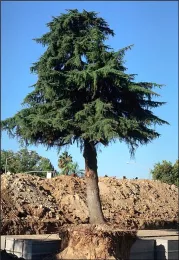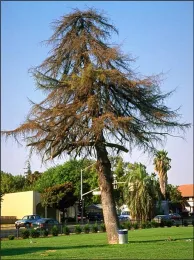Root Cutting May Have Long Term Consequences

Most mature trees will not show any immediate effects of root cutting, such as wilted leaves or branch dieback, even when a fairly large number of roots are cut. Indeed, root cutting is a routine practice where landscapes are being renovated or sidewalks are being repaired. However, it's the long term effects of root cutting that needs consideration.
Roots can decay when they are attacked by microorganisms, usually fungi, that live in the soil. The microorganisms often infect a root through a wound, but some are able to penetrate a root directly, especially if the tree has been weakened by drought or overwatering. Some root rot fungi can kill a tree before it falls, others cause living and healthy looking trees to fall. You can sometimes see trees blown over with the remains of their decayed root systems still attached.
It is often very difficult to detect rotting roots, since the problem takes place out of sight below ground. Trees infected with root rot fungi sometimes have visible fruiting structures of the fungus, called conks or mushrooms, on the trunk near the ground. If you see such signs on a large tree, consider having the tree inspected by a qualified arborist.

Construction activities or trenching are especially damaging to the roots of nearby trees. Trenching and earth moving equipment used around trees often sever a large portion of the existing tree roots. Without the support of the entire root system, the tree is structurally weakened. The probability of failure increases as a greater amount of the root system is cut or damaged.
It is usually impossible to predict the exact effect that root cutting will have on a particular tree, or when an effect will occur. A tree may fail a few months or many years following root injury, or it may never fail due to the root injury. Tree species vary in their ability to tolerate root disturbances. Also, no two root systems are exactly alike. A tree with a deep, extensive root system will tolerate more disturbance than a neighboring tree with a poorly developed root system. In general, it is important to take every step possible to avoid cutting or damaging a tree's root system.
Despite an occasional failure, most large trees are very safe. Root systems are well designed by nature to hold trees up, regardless of the tree's size. For the most part, they do just that.
Ed Perry is the emeritus Environmental Horticultural Advisor for University of California Cooperative Extension (UCCE) in Stanislaus County where he worked for over 30 years.
